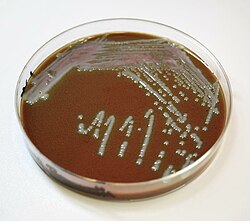Tularemia
Tularemia (also called "Goblin Fever", "deer-fly fever", "Ohara fever" and "Francis disease") is a disease. Usually rodents get it. It is caused by a bacterium, Francisella tularensis. There have been cases where the disease spread to humans. The disease can be treated with antibiotics.
Tularemia as a biological weapon
Cases of tularemia should be reported to the local health authority. The Centers for Disease Control and Prevention think F. tularensis could possibly be a bioweapons agent. For this reason, it has been included in the biological warfare programs of the USA, USSR and Japan at various times.[1] A former Soviet biological weapons scientist, Kenneth Alibek, has said that an outbreak of Tularemia among German soldiers shortly before the siege of Stalingrad was due to intentional release of F. tularensis by Soviet forces, but this claim is rejected by others who have studied the outbreak.[2] In the USA, practical research into using Tularemia as a bioweapon took place at Camp Detrick in the 1950s. It was viewed as an attractive agent because:
- it is easy to aerosolize
- it is highly infective; 10-50 bacteria are required to infect
- it is non-persistent and easy to decontaminate (unlike anthrax)
- it is highly incapacitating to infected persons
- it has low lethality, which is useful where enemy soldiers are in proximity to non-combatants, e.g. civilians
By the late 1950s the US biological warfare program was focused mostly on tularemia as a biological agent. The Schu S4 strain was standardized as Agent UL for use in the M143 bursting spherical bomblet. It was a lethal biological with an anticipated fatality rate of 40 to 60 percent. The rate-of-action was around three days, with a duration-of-action of one to three weeks (treated) and two to three months (untreated) with frequent relapses. UL was streptomycin resistant. The aerobiological stability of UL was a major concern, being sensitive to sun light, and losing virulence over time after release.
The United States later changed the military symbol for UL to TT (wet-type) and ZZ (dry-type) in an effort to retain security on the identity of military biologicals. When the 425 strain was standardized as agent JT (an incapacitant rather than lethal agent), the Schu S4 strain's symbol was changed again to SR.
No vaccine is available to the general public.[3] The best way to prevent tularemia infection is to wear rubber gloves when handling or skinning rodents or lagomorphs (as rabbits), avoid ingesting uncooked wild game and untreated water sources, and wearing long-sleeved clothes and using an insect repellent to prevent tick bites.
Documented outbreaks
In summer 2000, an outbreak of tularemia in Martha's Vineyard resulted in one dead person. It brought the interest of the CDC as a potential investigative ground for aerosolized Francisella tularensis. Over the following summers, Martha's Vineyard was identified as the only place in the world where documented cases of tularemia resulted from lawn mowing.[4] The research may prove valuable in preventing bioterrorism.
An outbreak of tularemia occurred in Kosovo in 1999-2000.[5]
In 2004, three researchers at Boston University Medical Center were accidentally infected with F. tularensis, after apparently failing to follow safety procedures.[6]
In 2005, small amounts of F. tularensis were detected in the Mall area of Washington, DC the morning after an anti-war demonstration on September 24, 2005. Biohazard sensors were triggered at six locations surrounding the Mall. To this date, no cases of tularemia infection have been reported as a result.[7]
In 2007, a lab of Boston University's Center for Advanced Biomedical Research, where F. tularensis were being kept for research, was evacuated after smoke set off alarms. An investigation has later determined that an electrical problem was the culprit, and no bacterial contamination was found.
In July 2007, an outbreak was reported in the Spanish autonomous region of Castile and León and traced to the plague of voles infesting the region.
Tularemia Media
Chocolate agar culture showing Francisella tularensis colonies
References
- ↑ Dennis DT et al. (2001) "Tularemia as a Biological Weapon: Medical and Public Health Management". JAMA 285:2763-2773
- ↑ Sjostedt, A (2007) "Tularemia: History, Epidemiology, Pathogen Physiology, and Clinical Manifestations." Annals of the New York Academy of Sciences 1105:1–29
- ↑ "Tularemia, NIAID Fact Sheet". Archived from the original on 2008-05-12. Retrieved 2008-05-01.
- ↑ Feldman KA, Enscore R, Lathrop S, et al. Outbreak of primary pneumonic tularemia on Martha's Vineyard Archived 2008-05-26 at the Wayback Machine. N Engl J Med 2001;345:1601--6.
- ↑ "Tularemia Outbreak Investigation in Kosovo: Case Control and Environmental Studies".
- ↑ Smith S (2005-03-29). City tells BU to bolster safety of its medical labs. Boston Globe. http://www.boston.com/news/local/articles/2005/03/29/city_tells_bu_to_bolster_safety_of_its_medical_labs/. Retrieved 2007-05-09.
- ↑ Dvorak P (2005-10-02). Health Officials Vigilant for Illness After Sensors Detect Bacteria on Mall: Agent Found as Protests Drew Thousands of Visitors. p. C13. https://www.washingtonpost.com/wp-dyn/content/article/2005/10/01/AR2005100101209.html. Retrieved 2007-05-08. "A week after six bioterrorism sensors detected the presence of a dangerous bacterium on the Mall, health officials said there are no reports that any of the thousands of people in the nation's capital Sept. 24 have tularemia, the illness that results from exposure to the bacteria.".

